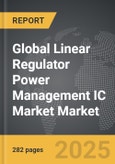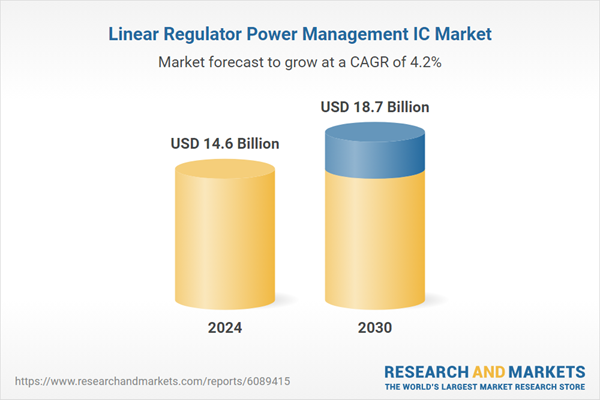Global Linear Regulator Power Management IC Market - Key Trends & Drivers Summarized
Why Are Linear Regulators Still Crucial in Power Management IC Design?
Despite the rise of highly efficient switching regulators, linear regulator ICs continue to hold a crucial role in power management due to their simplicity, low noise output, and ease of integration. Linear regulators are favored in noise-sensitive applications such as RF systems, analog signal chains, medical electronics, and instrumentation where power ripple and EMI need to be minimized. Their low dropout (LDO) variants allow regulation of voltage even when the input is only slightly higher than the desired output, making them ideal for battery-operated and compact form factor devices.Linear regulators are widely used in end applications such as smartphones, wearables, automotive infotainment systems, and industrial sensors. Their compact footprint, minimal external components, and fast transient response provide a key advantage in low-power and space-constrained designs. As electronic products demand higher efficiency, greater stability, and compliance with strict noise standards, linear regulator ICs continue to offer a valuable solution, particularly for post-regulation of sensitive supply rails.
How Are Performance Improvements Enhancing Utility in Advanced Electronics?
Modern linear regulator ICs are evolving with improved quiescent current control, thermal resistance, and power density to support increasingly complex electronics. Ultra-low dropout voltages, enhanced PSRR (power supply rejection ratio), and fast load response are now common in new-generation LDOs. This is critical for high-precision analog and mixed-signal ICs in applications like medical imaging, high-speed communication modules, and automotive sensor networks.Vendors are also introducing linear regulators with integrated protection features - such as overcurrent, thermal shutdown, and reverse polarity protection - enabling safer and more robust system designs. Digital control interfaces like I²C and PMBus are being integrated into some linear regulators, allowing for smarter power sequencing, fault reporting, and dynamic output voltage adjustment. These enhancements are enabling linear regulators to support power delivery in increasingly sophisticated SoC and FPGA systems, particularly in applications requiring quiet analog rails and low dropout operation.
What End-Use Trends Are Influencing Market Demand Across Devices and Industries?
The adoption of IoT, edge computing, and low-power wearables is fueling demand for high-efficiency, ultra-low quiescent current linear regulators. These devices often operate in sleep or idle modes, where even minor leakage currents can affect battery life. As a result, linear regulator ICs optimized for minimal standby consumption are becoming essential in portable consumer and industrial electronics. In parallel, the automotive industry is deploying linear regulators in ADAS modules, dashboard systems, and in-cabin electronics that demand voltage precision and thermal stability.In the communications and datacenter space, linear regulators are used for powering timing circuits, PLLs, and analog front-ends, where noise must be minimized to prevent signal interference. Industrial control systems and robotics also rely on LDOs for localized power conditioning to sensors and actuators. As devices become smaller and more integrated, designers prefer linear regulators for rail-specific voltage management in multi-voltage systems, reinforcing their continued relevance in modern PCB layouts.
What Is Driving Global Growth in the Linear Regulator Power Management IC Market?
The growth in the linear regulator IC market is driven by the proliferation of low-power electronics, noise-sensitive applications, and the miniaturization of electronic devices. A key driver is the rise of battery-powered and IoT devices, which require stable and efficient power delivery with minimal design complexity. The automotive sector's growing reliance on electronics for control, monitoring, and infotainment is also driving adoption, especially as LDOs offer thermal resilience and quiet operation.Designers' preference for simplicity, fast integration, and cost-effectiveness is ensuring continued demand for linear regulators, even as switching regulators gain efficiency advantages. Technological improvements in dropout performance, current handling, and control logic are extending the capabilities of linear regulator ICs, positioning them for deployment in advanced, space-limited electronics. Moreover, the availability of robust power management portfolios from key semiconductor vendors is simplifying procurement for OEMs and system designers - fueling global market expansion across consumer, automotive, industrial, and communications segments.
Report Scope
The report analyzes the Linear Regulator Power Management IC market, presented in terms of market value (US$). The analysis covers the key segments and geographic regions outlined below:- Segments: Input Voltage (Low, Medium, High); Application (Automotive, Consumer Electronics, Industrial, Other Applications).
- Geographic Regions/Countries: World; United States; Canada; Japan; China; Europe (France; Germany; Italy; United Kingdom; Spain; Russia; and Rest of Europe); Asia-Pacific (Australia; India; South Korea; and Rest of Asia-Pacific); Latin America (Argentina; Brazil; Mexico; and Rest of Latin America); Middle East (Iran; Israel; Saudi Arabia; United Arab Emirates; and Rest of Middle East); and Africa.
Key Insights:
- Market Growth: Understand the significant growth trajectory of the Low Input Voltage segment, which is expected to reach US$11.3 Billion by 2030 with a CAGR of a 4%. The Medium Input Voltage segment is also set to grow at 4.8% CAGR over the analysis period.
- Regional Analysis: Gain insights into the U.S. market, valued at $4 Billion in 2024, and China, forecasted to grow at an impressive 7.6% CAGR to reach $3.8 Billion by 2030. Discover growth trends in other key regions, including Japan, Canada, Germany, and the Asia-Pacific.
Why You Should Buy This Report:
- Detailed Market Analysis: Access a thorough analysis of the Global Linear Regulator Power Management IC Market, covering all major geographic regions and market segments.
- Competitive Insights: Get an overview of the competitive landscape, including the market presence of major players across different geographies.
- Future Trends and Drivers: Understand the key trends and drivers shaping the future of the Global Linear Regulator Power Management IC Market.
- Actionable Insights: Benefit from actionable insights that can help you identify new revenue opportunities and make strategic business decisions.
Key Questions Answered:
- How is the Global Linear Regulator Power Management IC Market expected to evolve by 2030?
- What are the main drivers and restraints affecting the market?
- Which market segments will grow the most over the forecast period?
- How will market shares for different regions and segments change by 2030?
- Who are the leading players in the market, and what are their prospects?
Report Features:
- Comprehensive Market Data: Independent analysis of annual sales and market forecasts in US$ Million from 2024 to 2030.
- In-Depth Regional Analysis: Detailed insights into key markets, including the U.S., China, Japan, Canada, Europe, Asia-Pacific, Latin America, Middle East, and Africa.
- Company Profiles: Coverage of players such as Arora Aromatics Pvt. Ltd., Axxence Aromatic GmbH, BASF SE, Bedoukian Research, Inc., Chemical Point UG and more.
- Complimentary Updates: Receive free report updates for one year to keep you informed of the latest market developments.
Some of the 42 companies featured in this Linear Regulator Power Management IC market report include:
- ABLIC Inc.
- Advanced Linear Devices
- Analog Devices Inc.
- Diodes Incorporated
- Infineon Technologies AG
- KEC Corporation
- MaxLinear Inc.
- Microchip Technology Inc.
- Monolithic Power Systems Inc.
- Nexperia B.V.
- Nisshinbo Micro Devices Inc.
- NXP Semiconductors N.V.
- ON Semiconductor Corporation
- PREMA Semiconductor GmbH
- Renesas Electronics Corporation
- ROHM Co., Ltd.
- Sensitron Semiconductor
- STMicroelectronics N.V.
- Texas Instruments Incorporated
- WIN SOURCE ELECTRONICS
This edition integrates the latest global trade and economic shifts into comprehensive market analysis. Key updates include:
- Tariff and Trade Impact: Insights into global tariff negotiations across 180+ countries, with analysis of supply chain turbulence, sourcing disruptions, and geographic realignment. Special focus on 2025 as a pivotal year for trade tensions, including updated perspectives on the Trump-era tariffs.
- Adjusted Forecasts and Analytics: Revised global and regional market forecasts through 2030, incorporating tariff effects, economic uncertainty, and structural changes in globalization. Includes historical analysis from 2015 to 2023.
- Strategic Market Dynamics: Evaluation of revised market prospects, regional outlooks, and key economic indicators such as population and urbanization trends.
- Innovation & Technology Trends: Latest developments in product and process innovation, emerging technologies, and key industry drivers shaping the competitive landscape.
- Competitive Intelligence: Updated global market share estimates for 2025, competitive positioning of major players (Strong/Active/Niche/Trivial), and refined focus on leading global brands and core players.
- Expert Insight & Commentary: Strategic analysis from economists, trade experts, and domain specialists to contextualize market shifts and identify emerging opportunities.
Table of Contents
Companies Mentioned (Partial List)
A selection of companies mentioned in this report includes, but is not limited to:
- ABLIC Inc.
- Advanced Linear Devices
- Analog Devices Inc.
- Diodes Incorporated
- Infineon Technologies AG
- KEC Corporation
- MaxLinear Inc.
- Microchip Technology Inc.
- Monolithic Power Systems Inc.
- Nexperia B.V.
- Nisshinbo Micro Devices Inc.
- NXP Semiconductors N.V.
- ON Semiconductor Corporation
- PREMA Semiconductor GmbH
- Renesas Electronics Corporation
- ROHM Co., Ltd.
- Sensitron Semiconductor
- STMicroelectronics N.V.
- Texas Instruments Incorporated
- WIN SOURCE ELECTRONICS
Table Information
| Report Attribute | Details |
|---|---|
| No. of Pages | 282 |
| Published | December 2025 |
| Forecast Period | 2024 - 2030 |
| Estimated Market Value ( USD | $ 14.6 Billion |
| Forecasted Market Value ( USD | $ 18.7 Billion |
| Compound Annual Growth Rate | 4.2% |
| Regions Covered | Global |









